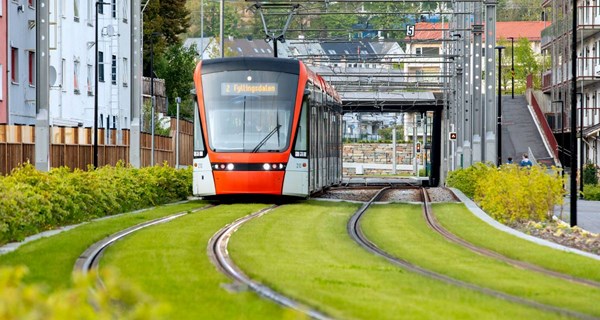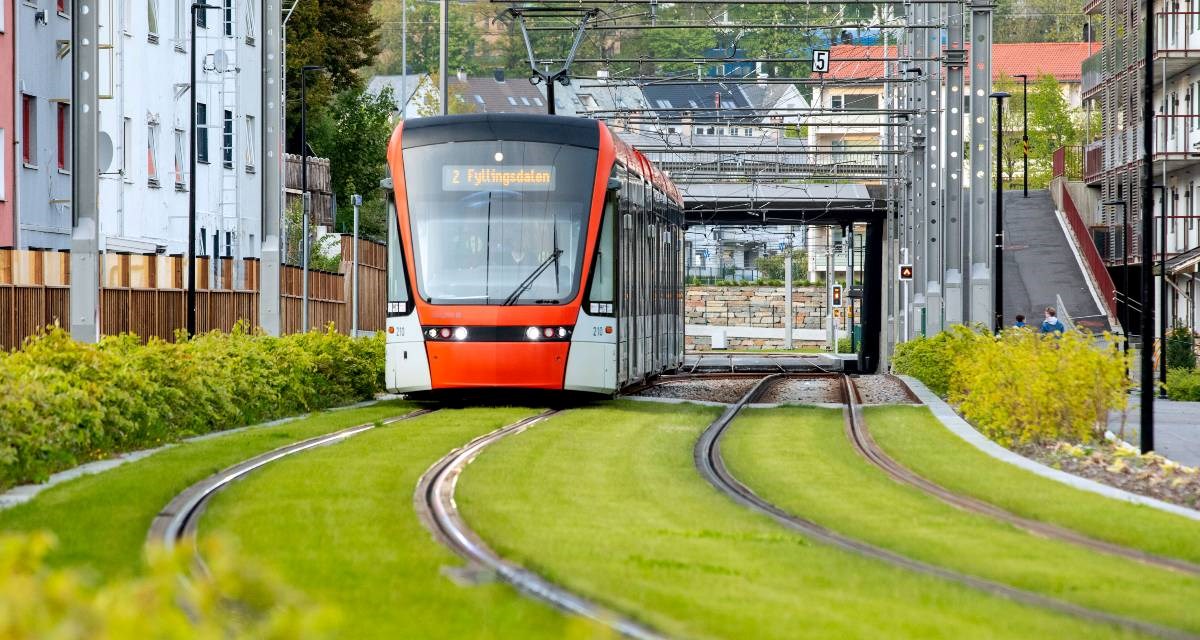Impact Report 2024
Our Impact Report presents the environmental impact of KBN's green lending programme as of 31 December 2024. All funds raised by KBN's green bond issuances are used to finance or re-finance green loans in the Norwegian municipal sector.
Photo: Iver Daaland Åse, Bybanen Utbygging
13.03.2025
Project portfolio and environmental impact
KBN’s green lending programme helps finance projects that reduce greenhouse gas emissions, improve energy efficiency, enhance the environment, and promote climate change adaptation. In 2024, KBN had outstanding green bonds totalling NOK 52 billion. By the end of the year, the outstanding green loan portfolio reached NOK 66 billion, accounting for 17.8% of KBN’s total lending. These projects led to an estimated annual reduction of 13 288 tonnes CO2e and production of 130 988 MWh of renewable energy, among other benefits.
Updated Green Bond Framework and nature criteria
KBN’s Green Bond Framework, updated in April 2024, governs KBN’s green bond programme. The framework defines eligible project types and KBN’s procedures for allocation, evaluation, and reporting, aligning with the ICMA Green Bond Principles. The new framework received an overall shading of Medium Green from SPO provider S&P Global. KBN’s reporting follows the Nordic Public Sector Issuers' Position Paper on Green Bonds Impact Reporting. The report includes both allocation and impact reporting, and the allocation of proceeds and environmental impact has been verified by KBN’s internal auditor, KPMG.
KBN has also strengthened the criteria for green loans in its Criteria Document, reviewed annually with input from KBN’s Green Expert Committee. A central new focus involves reducing negative impacts on nature and nature-related risks resulting from land-use changes. These evaluations require balancing the need for ecological preservation on one side and the need for municipal services on the other. With KBN’s new nature criteria projects demonstrating innovative and climate-friendly building practices may nonetheless be declined if they pose substantial negative consequences for biodiversity or valuable ecosystems.
EU Taxonomy and sustainability efforts
KBN has conducted a self-assessment of its green project portfolio against the EU Taxonomy. The results indicate that approximately 65% of KBN’s portfolio is identified as either aligned or partly aligned with the Substantial Contribution criteria of the taxonomy. However, challenges remain in achieving full alignment with both Substantial Contribution and ‘Do No Significant Harm’ (DNSH) criteria, partly due to lack of data. KBN has a strategic goal of being a leading financial institution in green finance. Among its efforts is developing a model to evaluate ESG risk in the municipal sector.
Project portfolio with examples
By year end 2024, KBN financed a total of 537 green projects, of which 65 were new. The new green projects in 2024 encompass a wide range of initiatives across all seven project categories:
- In buildings, projects include new low-energy buildings, the use of climate-friendly materials, and the renovation of existing buildings for energy efficiency and reduced emissions. Examples include a new health centre with significantly lower energy requirements in Narvik municipality, and Trøndelag county municipality’s rehabilitation of a school aiming for net-zero emissions.
- In renewable energy, financing provided for new biogas plants, geothermal energy production systems, and the installation of heat pumps. For instance, a new energy centre with energy wells and heat pumps was established to heat a secondary school in Hustadvika municipality.
- For transportation, projects encompass the procurement of electric trucks and projects facilitating walking and cycling, as well as the expansion of the Bergen Light Rail which promotes sustainable public transport.
- In waste and circular economy, projects include the establishment of reuse centres and upgrades to facilitate CO2 storage. A new reuse centre at IVAR IKS was established with the goal of significantly increasing the sale of recycled goods.
- In water and wastewater management, financing supported the upgrading of treatment plants, the rehabilitation of dams using climate-friendly concrete, and the establishment of new water supply systems. Oslo municipality is securing a new backup water supply through emission-free tunnelling and construction of a new treatment plant.
- For land use and area development projects, new efforts involved climate-friendly port development and the upgrade of artificial turf fields to eliminate plastic pollution. An artificial turf field was upgraded to a non-infill type to prevent plastic pollution in Vega municipality.
- In climate change adaptation, financing supported the relocation of a water treatment plant to mitigate climate risk.

Impact Report 2024
See the environmental impact of our green loan program.
Impact report spreadsheet 2024 (XLSX 2MB)
Taxonomy alignment assessment 2024 (XLSX 0,7MB)

